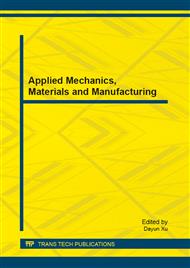[1]
QIU Liu-chao, JIN Feng. Study on method of earthquake input and artificial boundary c-onditions for seismic soil-structure interaction analysis [J]. Rock and Soil Mechanics, 2006, 27(9): 1501-1504.
Google Scholar
[2]
Qiu Liu-chao, Liu Hua, Jin Feng. Time-domain finite-element analysis of two dimensional seismic soil-structure interactions [J]. Engineering mechanics, 2006, 23(9): 114-119.
Google Scholar
[3]
Kausel, E. Local Transmitting Boundaries [J]. Engng Mech, 1988, 114(6): 1011~1027.
DOI: 10.1061/(asce)0733-9399(1988)114:6(1011)
Google Scholar
[4]
Clayton R, Engquist B. Absorbing Boundary Conditions for Acoustic and Elastic Wave Equations [J]. Bull. Seism. Soc. Amer., 1977, 76 (2): 1529~1540.
DOI: 10.1785/bssa0670061529
Google Scholar
[5]
Liao Zhen-peng, Huang Kong-liang, Yang Bai-po. The transient wave transmitting boundary [J]. China Science(A album), 1984, 26 (6): 50~56.
Google Scholar
[6]
Deeks A J, Randolph M.F. Axisymmetric Time-domain Transmitting Boundaries [J]. Journal of Engineering Mechanics, ASCE, 1994, 120 (1): 25~42.
DOI: 10.1061/(asce)0733-9399(1994)120:1(25)
Google Scholar
[7]
Lysmer J, Kuhlemeyer R L. Finite dynamic model for infinite media [J]. Journal of the Engineering Mechanics Division, ASCE, 1969, 95(1): 859-877.
DOI: 10.1061/jmcea3.0001144
Google Scholar
[8]
LIU Jing-bo, GU Yin, DU Yi-xin. Consistent visco-elastic artificial boundaries and visco-elastic boundary elements [J]. Chinese Journal of Geotechnical Engineering, 2006, 28(9): 1071-1075.
Google Scholar
[9]
Liu Jingbo, Lu Yandong. A direct method for analysis of dynamic soil-structure interaction based on interface idea [M]. In: Zhang Chuhan, Wolf J P, edited, Dynamic Soil-Structure Interaction. Academic Press, 1997. 258~273.
DOI: 10.1016/s0165-1250(98)80018-7
Google Scholar
[10]
Du Xinghua, Gao Yang. Application of viscoelastic artificial boundary in the finite element analysis [J]. Low Temperature Architecture Technology, 2012, (1): 76-78.
Google Scholar
[11]
Liu Jing-bo, Wang Zhen-yu, Zhang Ke-feng. Considering soil-structure interaction of large dynamic machine foundation of 3 D finite element analysis [J]. Engineering mechanics, 2002, 19(3): 34-38.
Google Scholar
[12]
Liu Jing-bo, DU Yi-xin, YAN Qiu-shi. Visco-elastic and the ground motion input implement in the general finite element software [J]. Journal of Disaster Prevention and Mitigation Engineering, 2007, (4).
Google Scholar


